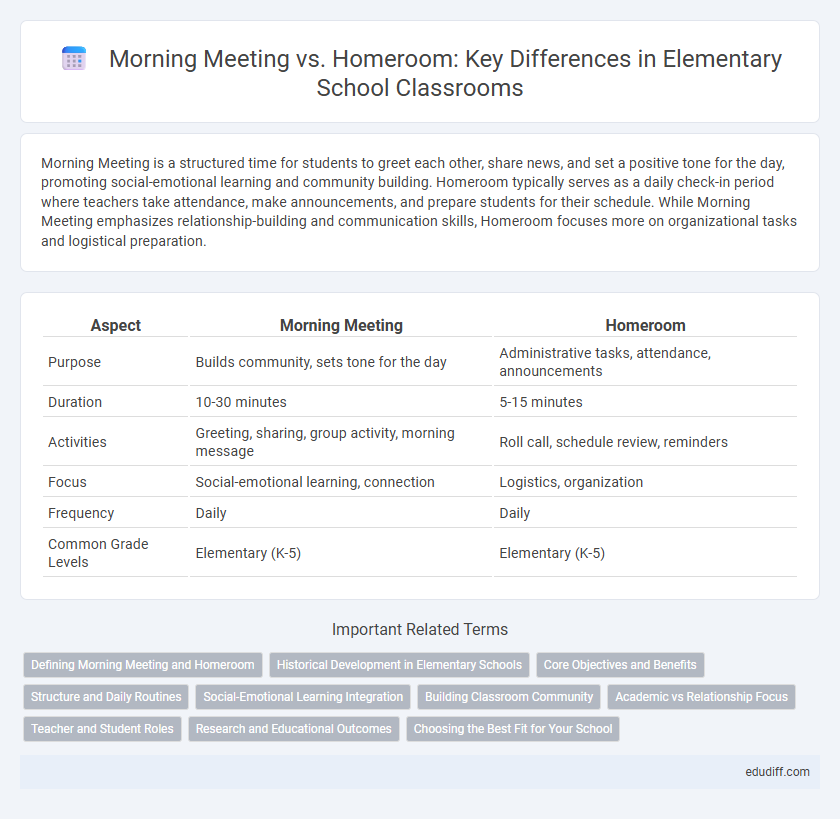Morning Meeting is a structured time for students to greet each other, share news, and set a positive tone for the day, promoting social-emotional learning and community building. Homeroom typically serves as a daily check-in period where teachers take attendance, make announcements, and prepare students for their schedule. While Morning Meeting emphasizes relationship-building and communication skills, Homeroom focuses more on organizational tasks and logistical preparation.
Table of Comparison
| Aspect | Morning Meeting | Homeroom |
|---|---|---|
| Purpose | Builds community, sets tone for the day | Administrative tasks, attendance, announcements |
| Duration | 10-30 minutes | 5-15 minutes |
| Activities | Greeting, sharing, group activity, morning message | Roll call, schedule review, reminders |
| Focus | Social-emotional learning, connection | Logistics, organization |
| Frequency | Daily | Daily |
| Common Grade Levels | Elementary (K-5) | Elementary (K-5) |
Defining Morning Meeting and Homeroom
Morning Meeting is a structured daily gathering in elementary classrooms designed to build community, set a positive tone, and foster social-emotional learning through greetings, sharing, and group activities. Homeroom, in contrast, serves primarily as an administrative and organizational period where teachers take attendance, make announcements, and distribute materials, focusing on routine classroom management. Understanding these distinct roles helps educators effectively balance community building with logistical tasks in early education settings.
Historical Development in Elementary Schools
Morning Meeting originated in the Responsive Classroom approach developed in the 1980s to foster social-emotional learning and community building in elementary schools, emphasizing student engagement and positive behavior. Homeroom, a more traditional practice dating back to early 20th-century education systems, primarily served administrative and organizational functions such as attendance and announcements. Over time, Morning Meeting has gained prominence for its structured routine that supports both academic readiness and emotional development, while Homeroom remains a foundational daily gathering focused on logistical tasks.
Core Objectives and Benefits
Morning Meeting fosters social-emotional learning by building community, establishing routines, and enhancing communication skills, which improves student engagement and classroom climate. Homeroom primarily focuses on administrative tasks such as attendance, announcements, and homework collection, streamlining daily organizational needs. Both support structure and routine but Morning Meeting emphasizes relationship-building and emotional readiness while Homeroom centers on logistical preparation for the school day.
Structure and Daily Routines
Morning Meeting follows a structured format that includes greeting, sharing, group activity, and morning message to build community and set a positive tone. Homeroom focuses on administrative tasks such as attendance, announcements, and organizing materials, providing time for students to prepare for the day. Both routines help establish consistency but serve different purposes in daily classroom management.
Social-Emotional Learning Integration
Morning Meeting emphasizes social-emotional learning by fostering community, building relationships, and promoting emotional expression through structured greetings, sharing, and group activities. Homeroom primarily serves administrative purposes but can incorporate social-emotional components like check-ins and goal setting to support student well-being. Integrating SEL in Morning Meetings creates a consistent, intentional space for students to develop self-awareness, empathy, and communication skills daily.
Building Classroom Community
Morning Meeting fosters a strong classroom community by encouraging daily student interaction through greetings, sharing, and group activities. Homeroom typically serves administrative purposes such as attendance and announcements, offering fewer opportunities for social bonding. Prioritizing Morning Meeting supports emotional connections and collaborative learning essential for a positive classroom environment.
Academic vs Relationship Focus
Morning Meeting centers on building a positive classroom community through social-emotional learning and relationship-building activities, enhancing students' sense of belonging. Homeroom primarily serves administrative and organizational purposes, such as attendance and morning announcements, with less emphasis on academic engagement. Research shows that Morning Meetings boost student collaboration and communication skills, directly supporting academic success through a relational approach.
Teacher and Student Roles
Teachers lead morning meetings by setting a positive tone and guiding students through daily goals, fostering social-emotional learning. In homeroom, teachers manage administrative tasks like attendance and announcements, establishing classroom routines. Students actively participate in morning meetings to build community, while in homeroom, they focus on organization and preparation for the academic day.
Research and Educational Outcomes
Research shows Morning Meetings enhance social-emotional learning by promoting student engagement and classroom community, leading to improved academic performance. Homeroom primarily serves administrative purposes, such as attendance and announcements, with less impact on educational outcomes. Studies indicate that schools implementing Morning Meetings report higher student motivation and collaboration skills compared to those relying solely on traditional Homeroom periods.
Choosing the Best Fit for Your School
Morning Meeting fosters community and social-emotional learning through structured greetings, sharing, and group activities, making it ideal for schools prioritizing student connection and daily engagement. Homeroom serves as a practical space for administrative tasks, attendance, and announcements, supporting schools focused on organization and routine. Choosing between these depends on whether your school values building relationships and social skills or streamlining daily management and logistics.
Morning Meeting vs Homeroom Infographic

 edudiff.com
edudiff.com